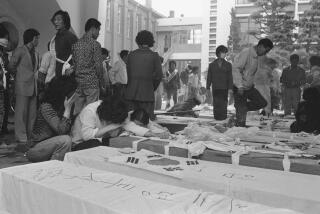Old-Time Coronerâs Reports Shed Light on Deaths
ST. LOUIS â On the surface, former Missouri Lt. Gov. Thomas Reynolds had everything: a wife, community stature, a law practice in St. Louis.
But a coronerâs inquest conducted at Lynchâs Undertaking Establishment tells a different story of Reynolds, who left Missouri briefly with other Confederate exiles during the Civil War.
A friend said Reynolds had seemed nervous the morning of his death on March 30, 1887, unable even to concentrate on his morning newspaper.
âHe was laboring under an irresistible impulse to destroy himself,â George Maverick told the St. Louis coroner investigating the suspicious death.
Reynolds plunged three floors to his death down the freight elevator shaft at the U.S. Custom House. Tucked in his pocket was a sealed envelope, with instructions not to open it until after his death.
This and other richly detailed stories from coronerâs inquests in St. Louis and six Missouri counties are online at the Missouri secretary of stateâs website as abstracts, indexed for the first time, to access the major collection. The time span varies by county, but together, the records cover 90 years, from 1842 to 1932.
Although states are beginning to provide genealogical information online, such as death and marriage records, itâs fairly unusual to publish coronerâs inquests on the Internet, said Kathleen Roe, vice president of the Council of State Historical Records Coordinators, an organization of state archivists. Illinois, however, has an online index of coronerâs inquests from 1871-1911.
Coronerâs inquests were medical and legal investigations into deaths resulting from something other than natural causes. They often were conducted on the spot, and in locations as varied as saloons and undertaker parlors. The witness depositions reveal the language and color of the time.
In the investigation into the death of little Edward Farris, St. Louis streetcar conductor Howard Tillotsan described how, on June 21, 1877, he âheard the cry of a child,â just as the 2-year-old was trampled by a frightened horse.
Tillotsan told the coroner that he gathered up the boy, âbut then, I met a man who at once took the child from my arms.â
State Archivist Kenneth Winn said the records, which in some cases predate newspaper archives, offered a unique look into 19th and early 20th century life in St. Louis and the counties of Andrew, Cape Girardeau, Clinton, Perry, St. Francois and Stoddard. Other counties will be added.
Winn said the records were a primary research tool for genealogists and scholars, but had been underused and underappreciated.
They re-create immigrant neighborhoods, and offer insights into homicide and suicide rates, the Populist farm movement, urban industrial strife, skirmishes between Bushwackers and Union troops, and, as in the case of Reynolds, a personâs state of mind in the hours before death, Winn said.
Theyâre useful to researchers of social or ethnic violence, labor, farm-to-urban migration, and the stress of living in the 1800s and early 1900s.
They even suggest what motivated the Temperance Movement.
âAmerican society was drunk in the 1830s and â40s,â Winn said. âThere was lots of alcoholic death.â
And, apparently, pockets of hopelessness too. The database contains 2,871 suicides. There were many deaths by drowning in river communities. One-fourth of the deaths investigated in St. Francois County, in Missouriâs mineral belt, resulted from mining accidents.
The original coronerâs inquest records, penned with flourishes or typed, are stored in modern-day coronerâs offices across Missouri, such as in the basement, right below the morgue, of the St. Louis medical examinerâs office.
Most have been microfilmed to preserve the contents of the fragile, brittle papers.
The early 1840s records tend to be brief, but they grow by the late 19th century.
The St. Louis records, especially, âtook our breath away.... They far exceeded what we imagined they would be,â Winn said.
Take, for instance, a coronerâs inquest into the death of state Sen. Peter Morrissey, a saloonkeeper, who was shot in the head by his girlfriend, Maud Lewis, on May 13, 1895, in a St. Louis brothel. Heâd said he was going to âcall onâ another woman.
Servant Lillie Moss ran to a neighboring bar to report the shooting to police. Lewisâ final words to her lover, were, âOh Pete, oh Pete, come back to me.â
The death of levee hand William Lyons by âStagâ Lee Shelton, also known as âStagger Lee,â âStagoleeâ and other variations, became legendary in the South, and the story was told in a hit R&B; record in 1950.
The coronerâs report said that on Christmas night in 1895, the friends were in Curtisâ Saloon in St. Louis when they began quarreling over a hat. Shelton fired the fatal shot and was later arrested. Lyons died at City Hospital early the next morning.
Stanford University law professor Lawrence Friedman praised Missouriâs efforts, and sees the coronerâs inquests as a resource for social, legal and criminal justice historians. His own students have used them.
âThey cast light on the underbelly of American history,â he said. âTheyâre mostly about losers, people who went off to make a fortune and didnât.â
More to Read
Sign up for Essential California
The most important California stories and recommendations in your inbox every morning.
You may occasionally receive promotional content from the Los Angeles Times.










